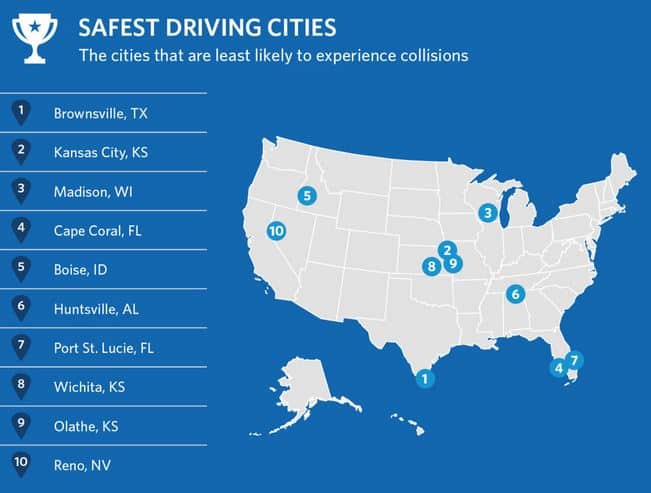 Allstate Insurance Company released its 12th annual America’s Best Drivers Report. The safest cities are
Allstate Insurance Company released its 12th annual America’s Best Drivers Report. The safest cities are
- Brownsville, TX.
- Kansas City, KS.
- Madison, WI.
- Cape Coral, FL.
- Boise, ID.
- Huntsville, AL.
- Port St. Lucie, FL.
- Wichita, KS.
- Oather, KS.
- Reno, NV.
Allstate created its America’s Best Drivers Report to facilitate an ongoing dialogue about safe driving, to help save lives.
Allstate’s report is the result of an in-depth examination of company claims data, to determine the likelihood drivers in America’s 200 largest cities will experience a vehicle collision compared to the national average. This year, Allstate actuaries analyzed property damage claims reported during the two-year period of January 2013 to December 2014. A weighted average of the two-year numbers determines the annual percentages.
The report defines a collision as any auto crash resulting in a property damage claim. Allstate’s auto policies represent nearly 10 percent of all U.S. auto policies, making this report a realistic snapshot of what’s happening on America’s roadways.
For the second straight year, the report also provides insight into braking habits in more than 100 cities across the country, using hard-braking data culled from Allstate’s Drivewise offering, an innovative technology that enables consumers to monitor their driving habits to improve safety and gain rewards on their insurance.
We looked into the report to see the worst 10 cities.
- 200. Boston, MA.
- 199. Worchester, MA.
- 198. Baltimore, MD
- 197. Washington D.C.
- 196. Springfield. MA.
- 195. Glendale. CA.
- 194. Providence, RI.
- 193. Los Angeles, CA.
- 192. Philadelphia, PA.
- 191. San Francisco, CA.
- 190. New Haven, CT.
National safety experts say drivers are now spending more time on the road and suffering more fatal collisions than recent years. The U.S. Department of Transportation says that from March 2015 to February 2016 Americans drove 3.15 trillion miles, an increase of more than 3 percent over the previous 12 months and the largest year-to-year increase in over two decades.ii According to the National Safety Council, more than 38,000 roadway fatalities occurred last year, the highest count since 2008iii.
Preventable human factors, like drunk, distracted or drowsy driving; speeding; and failure to use safety features contribute to 94 percent of car crashes.iv IIHS says intoxication is a significant factor in Fourth of July crash fatalities, with 42 percent between 2010 and 2014 involving at least one driver with a blood-alcohol concentration over the legal driving limit of .
Hard Breaking indicates problems.
Nationally, on average, a driver will experience 19 hard-braking events for every 1,000 miles driven. The following are the cities with drivers who experience the fewest hard-braking events per 1,000 miles driven
Drivewise Hard-Braking Events
(Cities’ drivers with the fewest events per 1,000 miles)
- Madison, Wis. 9.0
- Anchorage, Alaska 9.3
- Honolulu, Hawaii 10.1
- Des Moines, Iowa 10.5
- Wichita, Kan. 11.1
- Boise, Idaho 11.6
- Lincoln, Neb. 11.7
- Kansas City, Kan. 12.0
- Chesapeake, Va. 12.2
- Jackson, Miss. 12.2
To Deal with Hard Braking while Driving:
- Leave room between you and other vehicles. Hard-braking collisions can occur when drivers are following other cars too closely, causing a rear-end collision. Try to avoid rear-end collisions by leaving more space and time to react to other vehicles’ actions.
- Minimize distractions while driving. Distracted driving is one of the main causes of collisions.v Common driving distractions include eating, grooming, talking on a cell phone or texting, interacting with other passengers, adjusting navigation devices and playing loud music.
